Abstract
The indicator values of foundry coke quality are determined by means of testing at coke plants. As a rule, the consumers of foundry coke and foundry enterprises are located at a distance from coke plants. Foundry coke is transported in bulk in the open railroad cars. In this regard, the aim of this work is to reveal the effect of transportation on the quality of foundry coke. To determine the effect of transportation distance, the destruction index PT (%) was introduced. The experimental results have shown that the destruction degree of foundry coke is not the same at different transportation intervals. When transporting over distances up to 300 km, the coke with the minimum value of M40 durability index undergoes destruction. With an increase in the transportation distance from 900 to 2500 km, the destruction rate of foundry coke increases by 2.08–3.02% depending on the batch. For all batches, the formation of a fraction less than 40 mm was observed depending on the value of M40 durability index from 0.25 to 1.41%. For foundry coke characterized by high values of the durability index, the fraction of 80 mm or larger is kept during transportation. With an increase in the ambient air humidity during transportation by 40%, the moisture content in coke samples with a fraction of 40–60, 60–80, and 80 mm and larger increases more than in 24, 17, and 10 times, respectively. With a decrease in the air humidity by 34%, the amount of moisture in a gram of coke with a fraction of 40–60, 60–80, and 80 mm or larger decreases in 2 times, 1.26 times, and 1.45 times, respectively. Compared with coke with a fraction of 60–80 and 80 mm and larger, the moisture content of coke with a fraction of 40–60 mm increases at a higher rate with an increase in the ambient air humidity.


Similar content being viewed by others
REFERENCES
Lipnitskii, A.M., Plavka chuguna i splavov tsvetnykh metallov (Melting of Cast Iron and Non-Ferrous Alloys), Leningrad: Mashinostroenie, 1973.
Nefedov, P.Ya. and Strakhov, V.M., Quality and efficiency of utilization of foundry coke in cupola, Koks Khim., 2003, no. 7, pp. 16–26.
Matyukhin, V.I., Matyukhina, A.V., Babanin, V.B., Zorin, M.V., and Stakheev, S.G., Selecting the properties of metallurgical coke for cupola furnaces, Coke Chem., 2015, vol. 58, no. 3, pp. 96–100.
Dolinskii, V.A., Gainieva, G.R., and Nikitin, L.D., Influence of the composition and properties of coal batch on coke quality, Steel Transl., 2010, vol. 40, no. 2, pp. 105–107.
North, L., Blackmore, K., Nesbitt, K., and Mahoney, M.R., Methods of coke quality prediction: a review, Fuel, 2018, vol. 219, pp. 426–445.
Zhang, Q., Wu, X., Feng, A., and Shi, M., Prediction of coke quality at Baosteel, Fuel Process. Technol., 2004, vol. 86, no. 1, pp. 1–11.
Kishore, G.S., Jagannadham, G., and Alma, S., Coal blend modeling and coke quality prediction studies—GIKIL’s success story, Proc. Iron & Steel Technology Conf., May 2–5, 2011, Indianapolis, Indiana, USA, Warrendale, PA: Assoc. Iron Steel Technol., 2011, vol. 1, pp. 207–216.
Tiwari, H.P., Haldar, S.K., Roy, A., Bhattacharjee, A., and Mishra, P., Data mining—new perspectives on predicting coke quality in recovery stamp charged coke making process, Metall. Res. Technol., 2015, vol. 112, no. 6, pp. 603–618.
Koszorek, A., Krzesinska, M., Pusz, S., Pilawa, B., and Kwiecinska, B., Relationship between the technical parameters of cokes produced from blends of three Polish coals of different coking ability, Int. J. Coal Geol., 2009, vol. 77, nos. 3–4, pp. 363–371.
Lorez, D., Sanada, Y., and Mondragon, F., Effect to low-temperature oxidation of coal on hydrogen-transfer capability, Fuel, 1998, vol. 77, no. 14, pp. 1623–1628.
Sanchez, J.E. and Rincon, J.M., Oxidation paths of a coking coal and comparison of its oxidized product with a non-coking coal, Fuel, 1997, vol. 76, no. 12, pp. 1137–1142.
Smędowski, Ł. and Piechaczek, M., Impact of weathering on coal properties and evolution of coke quality described by optical and mechanical parameters, Int. J. Coal Geol., 2016, vol. 168, no. 1, pp. 119–130.
Nyathi, M.S., Kruse, R., Mastalerz, M., and Bish, D.L., Nature and origin of coke quality variation in heat-recovery coke making technology, Fuel, 2016, vol. 176, pp. 11–19.
Montiano, M.G., Díaz-Faes, E., and Barriocanal, C., Effect of briquette composition and size on the quality of the resulting coke, Fuel Process. Technol., 2016, vol. 148, pp. 155–162.
Montiano, M.G., Díaz-Faes, E., Barriocanal, C., and Alvarez, R., Influence of biomass on metallurgical coke quality, Fuel, 2014, vol. 116, pp. 175–182.
GOST (State Standard) 3340–88: Hard Coal Foundry Coke. Specifications, Moscow: Izd. Standartov, 1989.
Ivanova, V.A. and Yablonskii, O.P., Preparation of accreditation documents of factory testing laboratories in the field of quality control of foundry coke, Zavod. Lab., Diagn. Mater., 2013, no. 6, pp. 66–70.
GOST (State Standard) 22235–2010: Freight Cars for 1520 mm Gauge Main Line Railways. General Requirements for Safety in Loading-Unloading and Shunting Operations, Moscow: Standartinform, 2011.
TU 0761-032-00187852–2015. Koks liteinyi kamennougol’nyi. Tekhnicheskie usloviya (TU 0761-032-00187852–2015: Foundry Coal Coke. Technical Conditions), Tula: Tul’sk. Ugol’naya Komp., 2015.
MI 2083-90 GSI. Izmereniya kosvennye. Opredelenie rezul’tatov izmerenii i otsenivanie ikh pogreshnostei (MI 2083-90 GSI. Indirect Measurements. Determination of Measurement Results and Evaluation of Their Errors), Moscow: Izd. Standartov, 1991.
Ivanova, V.A. and Vdovin, K.N., Determining the wear and abrasive properties of foundry coke, Steel Transl., 2016, vol. 46, no. 3, pp. 165–168.
Ivanova, V.A. and Shamina, E.O., Effects of environmental humidity on the moisture content of casting coke, Solid Fuel Chem., 2018, vol. 52, no. 6, pp. 387–391.
Author information
Authors and Affiliations
Corresponding authors
Additional information
Translated by M. Astrov
About this article
Cite this article
Pobegalova, E.O., Ivanova, V.A. Effect of Transportation on the Quality of Foundry Coke. Steel Transl. 50, 762–766 (2020). https://doi.org/10.3103/S096709122011011X
Received:
Revised:
Accepted:
Published:
Issue Date:
DOI: https://doi.org/10.3103/S096709122011011X



